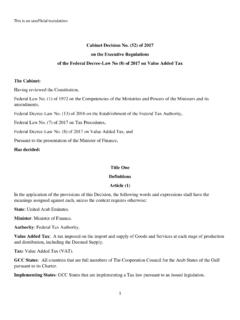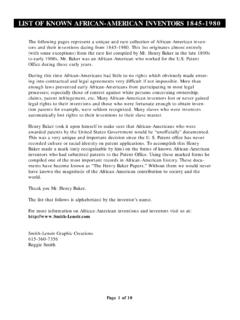Transcription of 1. Current Police Guidance - Leicester
1 Police Procedural Guidance for Parking and Obstruction Offences 1. Current Police Guidance Offences of unnecessary and wilful obstruction do exist, and do sit in the Police domain. Proceedings for obstructing the highway (including pavements) can be instituted under the following legislation: Wilful Obstruction of the Highway Section 137 Highways Act 1980. Fine Level 3. Fixed Penalty Summary Offence. Keyword: LEGAL BASIS. Unnecessary Obstruction Section 42 Road Traffic Act 1988. Fine Level 3. Fixed Penalty Summary Offence. Leaving Vehicles in Dangerous Position Section 22 Road Traffic Act 1988. Fine Level 3. Fixed Penalty Summary Offence that carries 3 penalty points and requires service of a Notice of Intended Prosecution. The main point required to prove an offence of unlawful obstruction of the pavement is that the obstruction is actual and not merely perceived. Consequently, somebody must have made a formal complaint in order for the Police to take action.
2 Examining Magistrates will also need to prove if the obstruction was, in all the circumstances, unreasonable. Keyword: ACTUAL. We must remain cognisant of the fact that in some built up urban areas if vehicles were not parked on the pavement some emergency vehicles would not get through. Essentially a situational and contextual approach is necessary. Keyword: CONTEXT/ROAD LAYOUT. If a wheelchair user or a mother with a double buggy cannot get through on the pavement and have to use the road to pass by, then consider offences of obstruction. But we need to adopt a far more pragmatic and diplomatic approach to these concerns. Keyword: DISCRETION. Unless the vehicle is causing a very real and unnecessary obstruction to other road users and somebody has made formal complaint, then prosecution action should not ordinarily follow. Keyword: NECESSITY/PROPORTIONALITY. 2. Additional factors Police Safer Neighbourhood Teams (SNTs) consult with communities to determine local Priorities'.
3 Where parking is not identified as a Priority other matters will be the focus of concerted Police action and problem solving. Conversely, where Parking is raised then punitive action and problem solving would be conducted. At present we have only one NH Priority concerning parking on the entire City Area despite each ward having in the region of two NH Priorities. This is on Spinney Hills Ward, in the area of The Circle and quite close to The Leicester General Hospital. (Keyham Lane LPU has also launched an initiative to reduce inconsiderate parking at a primary school. This is a City wide issue that relates more to parking on Yellow Zigzags.). With reducing budgets and an associated consolidation of areas of business, the Current approach to decision making is based around understanding and addressing the threat of harm and risk. Discretion is based around this concept. Consequently officers will make a subjective every case on its merits' assessment, and take action if appropriate.
4 It is likely that a good local officer will apply his/her local knowledge as opposed to waiting for a report/complaint' as at above. PCSOs now complete the greater part of Police foot patrols, and these are typically aimed at reducing ASB and Crime, and offering reassurance to communities. Though issuing tickets can be seen as an element of those patrols, and appropriate opportunities taken as they arise, it is not common for PCSOs to think in these terms. Policing in Leicester Leicestershire and Rutland is governed by Our Duty', which is: Protecting vulnerable people Dealing with those who cause most harm Effectively deploying our people Working with partners to solve locally identified problems Trusting our people to use their judgement to make good decisions Ensuring effective and efficient use of resources. 3. Current Considerations Nothing in the case study from Warwick appears at odds with the Current Police approach There is scope for the Police and LA CEOs to continue to work together to identify where their practices meet and or overlap, whilst maintaining appropriate discretion of individual officers.
5 It is recognised within Policing, and in particular by the City Senior Management Team, that owing to a range of factors resources need to be deployed on the basis of an assessment of threat, risk and harm. Our officers will be encouraged to make subjective decisions on this basis. Appendix A. During the past 12 months 14/4/13 to 14/4/14 we have had the following number of FPN's issued :- 203 for Unnecessary Obstruction 59 for Wilful Obstruction Both of these offences are dealt with by way of a 30 FPN. They are in the whole issued to those drivers who either :- a) park on pavements in such a manner that anybody wishing to pass the vehicle would have to enter the road, particularly those in wheelchairs or with pushchairs. b) park so close to the mouth of a junction that it becomes unsafe for other road users. The ( Police ) Legal Web has the following Q&A. What might amount to an obstruction of the road or a highway etc?
6 Answer There are a number of different general offences - If a person, without lawful authority or excuse, in any way wilfully obstructs the free passage of the highway, he commits an offence, (section 137 Highways Act 1980). 'Highway' means any public road and includes the whole or part of a highway, other than a ferry or waterway, (section 328(1)) and where a highway passes over a bridge or through a tunnel, that bridge or tunnel is to be taken as to be part of the highway (section 328(2)). It is an offence to wilfully cause an obstruction in any public footpath or public thoroughfare, (section 28 of the Town Police Clauses Act 1828). No person in charge of a motor vehicle or trailer shall cause or permit the vehicle to stand on a road so as to cause any unnecessary obstruction of the road (regulation 103 of the Road Vehicles (Construction and Use) Regulations 1986). It is an offence to park a heavy commercial vehicle wholly or partly (a) on the verge of a road or (b) on any land situated between two carriageways which is not a footway, or (c) on a footway (section 19 Road Traffic Act 1988).
7 The elements of the offences vary slightly. In Nagy v West (1965) it was held that the test of whether a particular use of a highway, by a vehicle, amounts to an obstruction is whether such use is unreasonable having regard to all the circumstances including its duration, position and purpose. Also, whether the unreasonable use caused an actual, as opposed to a potential, obstruction. Of the numerous decided cases on what might constitute an obstruction, Nagy v West (1965) is generally recognised as being the authoritative case on the issue. In respect of prosecutions under the Road Vehicles (Construction and Use). Regulations, in Solomon v Durbridge (1956) it was held that a motor vehicle left in a road for an unreasonable time may be an unreasonable obstruction. But, as was held in Nagy v West (1965) - 'while there must be proof of unreasonable use, whether or not use amounting to an obstruction was or was not unreasonable use, was a question of fact depending on all the circumstances,'.
8 The decision in Nagy v West (1965) was subsequently approved in Evans v Barker (1971), in which case it was held, following Solomon v Durbridge, that for the purposes of the regulation 103 offence, leaving a car for a reasonable time, although amounting to an obstruction, did not amount to an unnecessary obstruction. James Cooke Team Leader Process Prosecution Team Leicestershire Police .







